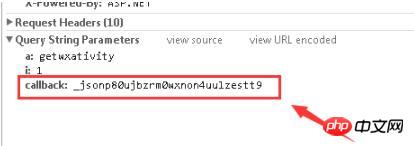
Below I will share with you a solution to the cross-domain problem based on vue-resource jsonp. It has a good reference value and I hope it will be helpful to everyone.
I recently encountered a problem with Ajax cross-domain requests while learning vue.js. I knew it could be solved with jsonp, but I have never practiced it. This time I found a lot of problems, so I will record it now. I hope it can be solved. Give some help to students who are new to using jsonp!
I won’t say much more about what jsonp is and why jsonp is used. Students who don’t understand can search it on Baidu.
Let’s first talk about the jsonp request in jQuery. It will be easy to understand the jsonp in vue-resource.
Here I take json data as an example. First, we can directly get an object we want through $.get, but when using jsonp, the error code will appear as follows,
$.ajax({
url:"http://192.168.8.59/weixinvip/VIP/ERP/Home/api.ashx?a=getwxativity&i=1",
type:"GET",
dataType:"jsonp",
sccuess:function(data){
console.log(data)
}
})
At this time we saw that the console did not output data as we expected, but reported an error.
At this time, we check the Network and see that the data has actually been requested.


We can see that the request was successful. Yes, the status code is 200, and the data is returned, but why is an error still reported?
This requires us to analyze the principle of jsonp:
First of all, when sending ajax, normally we get a piece of json data, but JS is inconvenient To directly operate json data, jQuery has automatically parsed it into a JS object for us at this time;
We all know that jsonp is actually equivalent to loading data in by using JavaScript to load a script
Speaking of this, I think some students have probably understood why the error is reported. In fact, at this time, a script is directly added to the page, and the content inside is the data returned to us
<script src="http://192.168.8.59/weixinvip/VIP/ERP/Home/api.ashx?a=getwxativity&i=1"></script>
Now let’s think about it again Think about it, this JavaScript code is actually a meaningless object, because you can’t get it without assigning it to a variable; so at this time we need the cooperation of our background colleagues. I believe that at this point, everyone You should all know how to do it, so we won’t go into detail about jQuery’s ajax.
Today we are mainly talking about the jsonp cross-domain request issue in vue-resource
Without further ado, let’s go directly to the code:
var vm = new Vue({
el:'#signRecord',
data:{},
beforeMount:function(){
this.$http.jsonp("http://192.168.8.59/weixinvip/VIP/ERP/Home/api.ashx?a=getwxativity&i=1")
.then(function(data){
console.log(data)
})
}
}) 
The same error was reported, and vue-resource reported another error to us. Let’s take a look at network


The same request was successful and the data was obtained, but an error was reported. If we look at the request header, we will find that there is an extra parameter


What is this parameter for? Let’s look at the source code

Here we can see that callback is actually a randomly generated string, and we can also name this parameter name ourselves, if it is not specified , the default is "callback", since
is the parameter passed by default, it must be useful.
In fact, there are two parameters for vue to send jsonp. Let’s take a look.
Vue.http.jsonp(url,{params: {pageID:29},jsonp:"_callback"}) //这步就是关键,改callback名Here params is the data object to be sent, and jsonp is the name of the callback, which is the callback name above; (The default is callback if not set). Now we need
background assistance to get the value of "_callpack" we sent, and splice this value into the returned json data. That's it!
The above is what I compiled for everyone. I hope it will be helpful to everyone in the future.
Related articles:
How to use javascript to obtain different prices every day within the date range
How to implement the image loading component in vue
Why will Node.js become a web application development?
The above is the detailed content of Regarding jsonp cross-domain issues in vue-resource. For more information, please follow other related articles on the PHP Chinese website!




